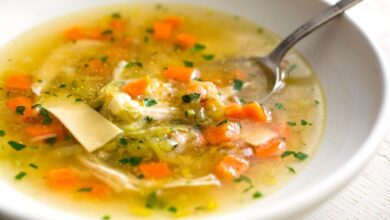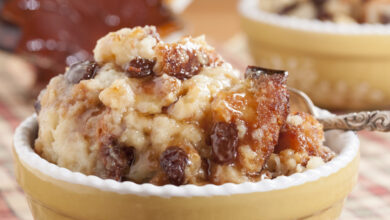
Bacon Gravy for Biscuits: A Southern Comfort Food Classic
Bacon gravy for biscuits is more than just a delicious topping – it’s a Southern culinary tradition with a rich history and a place in countless family recipes. From its humble beginnings to its modern-day popularity, this savory sauce has captivated taste buds and fueled countless meals.
This article delves into the world of bacon gravy, exploring its origins, ingredients, variations, and culinary applications. We’ll uncover the secrets behind its irresistible flavor and discover why it remains a beloved staple in kitchens across the South and beyond.
History and Origins of Bacon Gravy
Bacon gravy, a culinary delight that elevates humble biscuits to gourmet status, has a rich and fascinating history that spans centuries and continents. While its exact origins remain shrouded in culinary mystery, its journey from humble beginnings to a beloved staple of American cuisine is a testament to the power of simple ingredients and ingenious culinary innovation.
Early Influences and Origins
Bacon gravy, like many beloved culinary traditions, has roots in various cultures and historical periods. The use of bacon fat, a common byproduct of meat preservation, was widespread in ancient times. In medieval Europe, for instance, bacon fat was used for cooking and frying, and it was also incorporated into sauces and gravies.
The concept of using bacon fat to create a flavorful and savory gravy likely emerged from these early culinary practices.
The Rise of Bacon Gravy in American Cuisine
The evolution of bacon gravy in the United States is closely tied to the development of American cuisine. During the colonial era, settlers brought with them their culinary traditions, including the use of bacon fat and gravy. The emergence of the American South as a major agricultural and culinary center played a significant role in the popularization of bacon gravy.
Bacon Gravy in Southern Cuisine
Bacon gravy is an integral part of Southern cuisine, where it is often served alongside biscuits, grits, and fried chicken. Its rich, savory flavor complements the simple yet satisfying dishes that are characteristic of Southern cooking. In the South, bacon gravy is a symbol of comfort food and hospitality, a culinary tradition passed down through generations.
Ingredients and Preparation Techniques
Bacon gravy is a staple in Southern cuisine, and its preparation involves a few essential ingredients and a straightforward process. It’s a versatile dish that can be customized to suit individual preferences.This section delves into the ingredients, preparation techniques, and variations of this classic gravy.
We’ll explore the key components, discuss the steps involved in creating a delicious gravy, and highlight some alternative methods for preparing this beloved dish.
Essential Ingredients
The essential ingredients for a classic bacon gravy recipe are:
- Bacon: The star of the show, bacon provides the savory flavor and rich texture that defines bacon gravy. Choosing high-quality bacon, such as thick-cut or applewood-smoked, can enhance the overall taste and aroma.
- Flour: Flour acts as a thickening agent, creating the creamy consistency of the gravy. All-purpose flour is commonly used, but you can experiment with other types, such as wheat flour or gluten-free flour, depending on your dietary needs or preferences.
Sometimes, you just crave that classic Southern comfort food – biscuits smothered in creamy bacon gravy. But sometimes, you want something a little sweeter, a little more exotic. That’s when I turn to maja blanca coconut pudding , a Filipino dessert that’s rich, creamy, and just as satisfying.
It’s like a warm hug on a cold day, and it reminds me that good food can come from all over the world. But when it comes down to it, there’s nothing quite like the salty, savory goodness of bacon gravy for biscuits.
It’s a taste of home, and that’s something I’ll always cherish.
- Milk or Cream: The liquid base of the gravy, milk or cream adds moisture and richness. Whole milk or heavy cream are popular choices, but you can use skim milk or even buttermilk for a tangier flavor.
- Salt and Pepper: Seasoning is essential for enhancing the flavor of the gravy. Adjust the amount of salt and pepper to your taste preference.
- Optional Ingredients: You can add other ingredients to enhance the flavor of your bacon gravy. Common additions include:
- Black pepper: A touch of black pepper adds a spicy kick to the gravy.
- Garlic powder: Garlic powder adds a savory and aromatic dimension to the gravy.
- Onion powder: Onion powder adds a subtle sweetness and depth of flavor to the gravy.
- Cayenne pepper: A pinch of cayenne pepper adds a subtle heat to the gravy.
Preparation Techniques
The preparation of bacon gravy typically involves a few simple steps:
- Fry the bacon: Cook the bacon in a skillet over medium heat until crispy. This releases the bacon fat, which will be used to make the gravy.
- Make the roux: Once the bacon is cooked, remove it from the skillet and set aside. Whisk the flour into the remaining bacon fat, stirring constantly to create a smooth roux.
- Add the liquid: Gradually whisk in the milk or cream, stirring continuously to prevent lumps from forming.
- Simmer and season: Bring the mixture to a simmer, stirring constantly until the gravy thickens. Season with salt, pepper, and any other desired ingredients.
- Stir in the bacon: Once the gravy has thickened, stir in the cooked bacon.
Stovetop vs. Oven Methods
Bacon gravy can be prepared on the stovetop or in the oven.
Bacon gravy for biscuits is a classic comfort food, but sometimes you need a little more excitement on your plate. That’s where a hearty goya easy arroz con pollo comes in. It’s a vibrant dish with chicken, rice, and a blend of spices that will leave you wanting more.
But when you’re craving that creamy, savory bacon gravy, there’s nothing quite like the simple satisfaction of dipping a fluffy biscuit into its rich, flavorful depths.
- Stovetop method: This is the most common method for preparing bacon gravy. It allows for greater control over the cooking process and ensures the gravy thickens evenly.
- Oven method: The oven method involves baking the gravy in a shallow dish, allowing it to cook slowly and evenly. This method is ideal for large batches of gravy and can be helpful for keeping the gravy warm while you prepare other dishes.
Flavor Profiles and Variations
Bacon gravy is a culinary masterpiece that transcends the realm of mere sauce, becoming a symphony of savory notes. Its distinctive flavor profile is a testament to the artful combination of ingredients.The foundation of this culinary creation lies in the rich, smoky essence of bacon, which imparts a deep, savory depth to the gravy.
The fat rendered from the bacon, infused with its smoky aroma, forms the base of the gravy, providing a velvety texture and a lingering, tantalizing flavor. This fat is then combined with flour to create a roux, the thickening agent that gives the gravy its characteristic consistency.
Variations in Bacon Gravy Recipes
The versatility of bacon gravy allows for endless variations, catering to diverse palates and culinary preferences. One of the most common variations involves the type of bacon used. While traditional bacon is often favored, smoked bacon adds a more intense smoky flavor, while maple-flavored bacon imparts a subtle sweetness.Beyond the type of bacon, spices play a pivotal role in shaping the flavor profile of bacon gravy.
Common additions include black pepper, white pepper, cayenne pepper, garlic powder, onion powder, and paprika. These spices add layers of complexity and depth to the gravy, enhancing its overall flavor.
Regional and Cultural Variations in Bacon Gravy
Bacon gravy is a culinary tradition that has evolved over time, reflecting the diverse culinary landscapes of different regions and cultures.
- Southern Bacon Gravy:This variation is often made with a generous amount of bacon, resulting in a rich, intensely flavorful gravy. It is typically served over biscuits, grits, or fried chicken.
- Canadian Bacon Gravy:This variation utilizes Canadian bacon, which is a leaner, less fatty type of bacon. This results in a lighter, less greasy gravy that is often served with eggs and toast.
- Asian-Inspired Bacon Gravy:This variation incorporates Asian flavors, such as soy sauce, ginger, and garlic. It can be served over rice or noodles, creating a unique and flavorful dish.
Culinary Applications: Bacon Gravy For Biscuits

Bacon gravy, a staple in Southern cuisine, transcends its traditional role as a breakfast companion. Its versatility extends far beyond biscuits, making it a delicious addition to a variety of dishes.
Bacon Gravy’s Role in Various Dishes
Bacon gravy’s savory and rich flavor profile complements a wide array of culinary creations. Its salty, smoky essence adds depth and complexity to both sweet and savory dishes, making it a versatile ingredient in any kitchen.
Bacon gravy is a classic comfort food, perfect for drizzling over fluffy biscuits. It’s a dish that always brings back memories of cozy mornings and hearty meals. While I love the savory flavors of bacon gravy, sometimes I crave something a little sweeter and more indulgent.
That’s when I turn to a homemade Irish whiskey cream, like the one found on Cerita Kuliner. The rich, creamy texture and subtle whiskey notes are the perfect complement to a warm biscuit. But don’t get me wrong, there’s nothing quite like a good bacon gravy to satisfy a craving for a classic Southern breakfast.
- Biscuits:The classic pairing of biscuits and bacon gravy is a testament to their perfect harmony. The fluffy, buttery biscuits soak up the rich gravy, creating a satisfying and comforting bite.
- Eggs:Bacon gravy adds a savory twist to breakfast eggs, whether scrambled, fried, or poached. The creamy gravy coats the eggs, enhancing their flavor and creating a decadent breakfast experience.
- Vegetables:Bacon gravy can elevate the taste of simple vegetables like green beans, asparagus, or Brussels sprouts. The smoky gravy adds a depth of flavor and complements the natural sweetness of the vegetables.
Recipes Featuring Bacon Gravy
Bacon gravy’s versatility extends beyond traditional breakfast fare. Its flavor profile and creamy texture lend themselves to a variety of culinary creations.
- Bacon Gravy Shepherd’s Pie:This hearty dish features a layer of mashed potatoes topped with a savory mixture of ground beef, vegetables, and bacon gravy. The rich gravy adds a layer of flavor and richness to the dish.
- Bacon Gravy Mac and Cheese:This indulgent twist on a classic comfort food features macaroni pasta coated in a creamy cheese sauce infused with the smoky flavor of bacon gravy. The gravy adds a depth of flavor and a touch of indulgence to the dish.
- Bacon Gravy Chicken Pot Pie:This comforting dish features tender chicken and vegetables encased in a flaky crust and topped with a rich bacon gravy. The gravy adds a layer of richness and flavor to the dish, making it a satisfying and comforting meal.
Cultural Significance and Popularity
Bacon gravy is more than just a delicious topping; it’s a symbol of Southern comfort food and a cherished part of culinary traditions across various regions. Its popularity extends beyond regional boundaries, with its unique flavor profile and versatility making it a beloved dish worldwide.
Regional Variations and Traditions
Bacon gravy holds a special place in the hearts of many, especially in the Southern United States. In this region, it’s a staple breakfast item, often served over biscuits, grits, or fried potatoes. Its popularity extends to other parts of the country, where it’s enjoyed in various forms, from traditional Southern-style to more modern interpretations.
- Southern United States:In the South, bacon gravy is considered a quintessential comfort food. It’s a staple at breakfast, brunch, and even dinner, often served over biscuits, grits, or fried potatoes.
- Midwest:In the Midwest, bacon gravy is often enjoyed with pancakes or waffles. It’s also a popular topping for hash browns and other breakfast dishes.
- Northeast:In the Northeast, bacon gravy is less common than in other regions. However, it’s still enjoyed by some, especially in rural areas.
Comfort Food and Culinary Traditions, Bacon gravy for biscuits
Bacon gravy evokes a sense of nostalgia and comfort for many. Its rich, savory flavor and creamy texture provide a sense of warmth and satisfaction. The dish is often associated with family gatherings, holidays, and special occasions.
“Bacon gravy is the ultimate comfort food. It’s the kind of dish that makes you feel warm and fuzzy inside.”
Anonymous
The popularity of bacon gravy as a comfort food is rooted in its history and cultural significance. In many communities, it’s a dish that has been passed down through generations, with each family adding their own unique twist to the recipe.
Impact of Social Media and Food Trends
In recent years, social media has played a significant role in the popularity of bacon gravy. Food bloggers and influencers have shared their recipes and variations, inspiring home cooks to experiment with the dish. The rise of food trends, such as the “comfort food” trend, has also contributed to the popularity of bacon gravy.
- Food Bloggers and Influencers:Food bloggers and influencers have helped to popularize bacon gravy by sharing their recipes and variations on social media platforms like Instagram, TikTok, and YouTube. These platforms have provided a space for home cooks to share their love of bacon gravy and inspire others to try it.
- Food Trends:The rise of food trends, such as the “comfort food” trend, has also contributed to the popularity of bacon gravy. Comfort food is often associated with nostalgia and warm feelings, and bacon gravy is a perfect example of a dish that evokes these emotions.
Nutritional Considerations
Bacon gravy, while undeniably delicious, is not the healthiest addition to your diet. Its rich, savory flavor comes at a cost, with high levels of calories, fat, and sodium. Understanding these nutritional aspects can help you make informed decisions about consuming bacon gravy and explore healthier alternatives.
Calorie and Fat Content
Bacon gravy is a concentrated source of calories and fat. A typical serving size of 2 tablespoons contains around 100 calories and 10 grams of fat, with a significant portion being saturated fat. This high fat content contributes to the gravy’s rich texture and flavor but also increases the risk of heart disease and weight gain if consumed regularly.
Sodium Levels
Bacon gravy is also very high in sodium, with a 2-tablespoon serving containing around 300 milligrams. This high sodium content can contribute to high blood pressure, particularly for individuals with pre-existing cardiovascular conditions. Excessive sodium intake can also lead to water retention and bloating.
Health Implications of Frequent Consumption
While occasional enjoyment of bacon gravy is unlikely to cause significant harm, frequent consumption can contribute to various health issues. These include:
- Increased Risk of Heart Disease:The high saturated fat content in bacon gravy can raise LDL cholesterol levels, increasing the risk of heart disease.
- Weight Gain:The high calorie and fat content can contribute to weight gain, especially when consumed regularly.
- High Blood Pressure:The high sodium content can contribute to high blood pressure, potentially leading to cardiovascular problems.
Healthier Alternatives and Modifications
To reduce the nutritional impact of bacon gravy, you can consider these alternatives and modifications:
- Reduced-Fat Bacon:Using reduced-fat bacon can lower the overall fat content of the gravy.
- Low-Sodium Broth:Using low-sodium broth instead of regular broth can significantly reduce the sodium content.
- Skim Milk or Non-Fat Milk:Substituting whole milk with skim milk or non-fat milk can reduce the fat content.
- Vegetable Broth-Based Gravy:Using vegetable broth as the base instead of pan drippings can significantly lower the fat content and calories.
- Sautéed Mushrooms or Onions:Adding sautéed mushrooms or onions can add flavor and texture while reducing the need for bacon.
- Gravy Alternatives:Consider using alternative sauces, such as a mushroom gravy or a white wine sauce, to provide a similar flavor profile without the high fat and sodium content of traditional bacon gravy.






